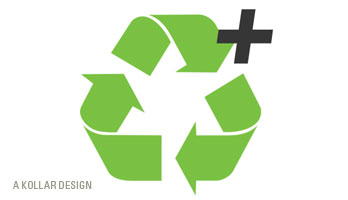When specifying printing papers for offset or digital printing, merely requesting “recycled” is not enough.
The term recycled can be misleading. Any of the following sources can make up all or part of your recycled paper choice, some having no positive environmental impact whatsoever.
Mill waste: Unprinted paper manufacturing byproducts such as clippings, rejected or obsolete papers. If your paper is 50% recycled (or less), it may be made of 50% virgin wood and 50% mill waste. Because mill waste has traditionally been reintegrated into the paper manufacturing process anyway, there’s really no energy or resource savings as a result of specifying this kind of recycled paper.
Pre-consumer waste: This is made of materials that have been printed, coated or processed that do not make it to the final product, for example, trimmings, make-ready sheets or manufacturing rejects from printers, binderies, etc. These by-products of the manufacturing process must be de-inked for reuse. Better than virgin paper, but, if we know what to ask for, we can do better.
Post-consumer waste: This is paper that has been used as a printed piece or packaging and has been rerouted by the consumer when they are done with it, typically through a recycle bin at home or at work. It also requires de-inking.
Paper and bleach
Traditionally, white paper has been bleached with chlorine. Dioxins, the most deadly toxic substance known to man, are a byproduct of the bleaching process. So, you have both health and climate impacts.
The alternative: “Process chlorine free” paper. This term refers only to recycled paper. The paper may have been bleached previously but there was no additional chlorine bleaching during the most recent recycling process.
The good news
Recycled papers have come a long way. There are wonderful 100% post-consumer waste, process chlorine free papers available today that are comparable in price, aesthetic and performance to traditional high-quality printing papers.
Net take-away
For minimum negative impact on the environment, specifically request a paper with the highest post-consumer waste content that is also process chlorine free.
Recommended resource:
One of our favorite paper companies is New Leaf Paper. Though the big paper companies now offer responsible choices, New Leaf is the little company that pioneered recycled papers and responsible manufacturing processes. Under the leadership of Jeff Mendelsohn, New Leaf has been educating printers and designers for decades. Check them out: http://www.newleafpaper.com/
©2013 Candice Kollar


